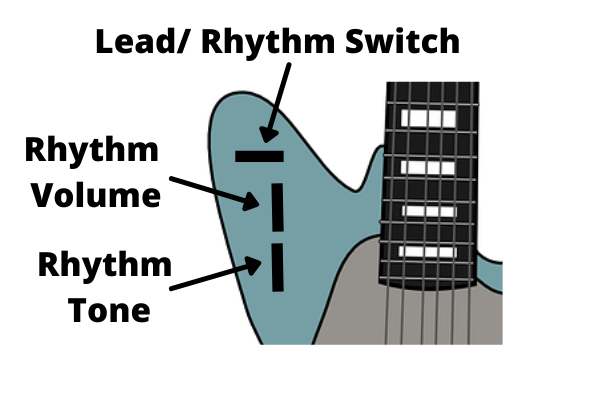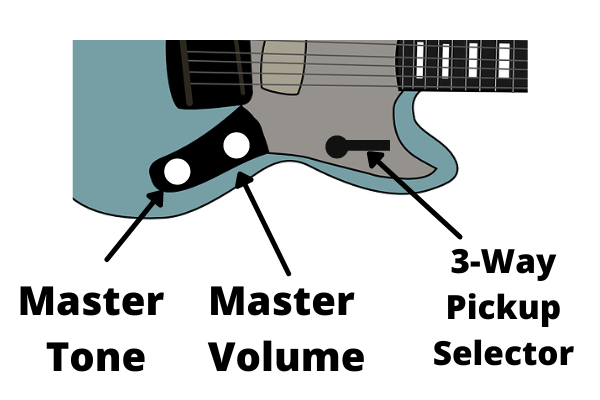The Mustang and Jazzmaster are two popular electric guitars originally produced by Fender. Since Squier started making more affordable options, the range has grown even more, and the models are popular amongst both beginners and professionals. In this article, I’ll compare these two guitars in terms of their tone, design and playability.
The Quick Answer
Mustang and Jazzmaster guitars have two single coil pickups, C-shape necks, and use similar tone woods. The main difference is that the Mustang has a shorter scale length and smaller body so is lighter than the Jazzmaster. The Jazzmaster sounds a bit warmer and fuller compared to the Mustang.
Comparing Models
First, let’s look at the designs of both guitars models. Here are two tables comparing the Fender American Performer Mustang and Fender Vintera Jazzmaster, and the more affordable Squier Classic Vibe models. Keep in mind that these are just two versions of each guitar types which are similarly priced, and some features may be slightly different depending on the model in question (more on that later).
Fender Mustang and Jazzmaster
| Feature | Fender Jazzmaster | Fender Mustang |
| Body Shape | Double Cutaway | Double Cutaway |
| Body Wood | Alder | Alder |
| Pickups | Two Wide Single-Coils | Two Single-Coils |
| Neck Shape | Mid-‘60s C | Modern-C |
| Neck Wood | Maple | Maple |
| Frets | 21 | 22 |
| Fretboard Wood | Pau Ferro | Rosewood |
| Scale Length | 25.5” | 24” |
| Tremolo | Yes | Yes |
| Rhythm/Lead Circuit | Yes | No |
| Pickup Selector | 3-way | 3-way |
| Weight | 8.5 pounds (3.9 kg) | 7 pounds (3.2 kg) |
Squier Mustang and Jazzmaster
| Feature | Squier Jazzmaster | Squier Mustang |
| Body Shape | Double Cutaway | Double Cutaway |
| Body Wood | Poplar | Poplar |
| Pickups | Two Single-Coils | Two Single-Coils |
| Neck Shape | C-shape | C-shape |
| Neck Wood | Maple | Maple |
| Frets | 21 | 22 |
| Fretboard Wood | Indian Laurel | Indian Laurel |
| Scale Length | 25.5” | 24” |
| Tremolo | Yes | Yes |
| Rhythm/Lead Switch | Yes | No |
| Pickup Selector | 3-way | 3-way |
| Weight | 8.5 pounds (3.9 kg) | 6-pounds (2.7 kg) |
Tone Differences
The Jazzmaster and Mustang are fairly similar sounding electric guitars, however the Jazzmaster sounds a bit fuller due to the higher output pickups, and the Mustang sounds slightly thinner which makes it suitable for genres such as surf. Both guitars can produce a range of tones, but the Jazzmaster is often considered more versatile.
Here is a video to help demonstrate the difference.
The Mustang has a smooth tone which played clean, particularly when using the neck pickup, but the bridge pickup does have a fair bit of grit when using overdriven amp settings. This makes the Mustang very popular for cleaner styles such as surf, funk but also heavier genres like grunge.
The controls on both guitars are quite different, which generates different possible tones.
The classic Jazzmaster models have a lead/rhythm circuit, which allows you to switch from warm to bright tones easily, making it a versatile guitar to play, especially if you’re not using effects pedals. Some Mustang models are very simple and just have 3-way pickup selector, whilst some have a phase switch for each pickup. When the switches are in the same position, they are “in-phase” produces a balanced tone. When the switches are in opposite positions, they are “out of phase” the tone sounds thinner with less bass and more treble.
I’ll compare the controls more in-depth, later in the article.
Look and Feel
The neck and body shape of the Mustang and Jazzmaster guitar models are fairly similar, the main difference is in the size. The Mustang has a shorter scale length by 1.5″ and a smaller body, making it around 2.5 pounds lighter than the Jazzmaster which is a fairly large model.
The Mustang was originally created as a “student guitar”, which explains its smaller size, as it was designed to be easier to play for newer guitarists. However, for players with longer arms, it might feel a bit too small.
Main Similarities:
- Similar C-shape necks.
- Offset double-cutaway body designs.
- 6 in-line head stock.
- Maple necks and alder bodies
Main Differences:
- Mustang has a smaller and lighter body than the Jazzmaster.
- The Jazzmaster has a longer scale length by 1.5″.
- The Jazzmaster has a larger pickguard which stretches to the upper horn, whereas the Mustang’s pickguard is located primarily on the lower horn and centre of the guitar.
I’ve written a complete buyer’s guide for electric guitars which takes you through all the things you need to consider and a step-by-step method to narrowing down your selection and choosing the best option. Here is a link to the article.
Comparing the Ranges
I also wanted to take a look at the Fender and Squier ranges. I’ve made two tables to show the key features and the current Guitar Centre price (at the time of writing) of most standard models in the range. The tables are all ordered from the lowest to the highest price so you can identify the options in your budget.
Here are some things to keep in mind:
- The Mustang was designed as a “student-guitar” so is often cheaper than the Jazzmaster.
- Only one American Mustang model is produced (American Performer), compared to the three main American Jazzmaster models.
- The Jazzmaster range caters for the high-end market more than the Mustang range.
Guitar Center are always the first place I look at when I’m interested in a new electric guitar because have a huge range of models for sale and always have some excellent deals on. Here’s a link to take you directly to Guitar Center’s electric guitar range so you can see all the offers available at the moment.
Squier Mustang vs Jazzmaster (Under $500)
| Guitar | Origin | Body Wood | Tremolo | Price |
| Squier Bullet Mustang HH | Indonesia | Basswood | No | $190 |
| Squier Affinity Jazzmaster HH | China | Alder | No | $230 |
| Squier Affinity Jazzmaster | China | Poplar | Yes | $280 |
| Squier Classic Vibe ‘60s Jazzmaster | Indonesia | Poplar | Yes | $430 |
| Squier Contemporary Jazzmaster | Indonesia | Poplar | No | $450 |
| Squier Classic Vibe Mustang | Indonesia | Poplar | Yes | $450 |
Fender Mustang vs Jazzmaster (Over $500)
| Guitar | Origin | Body Wood | Tremolo | Price |
| Fender Player Mustang | Mexico | Alder | No | $700 |
| Fender Player Jazzmaster | Mexico | Alder | Yes | $780 |
| Fender Vintera ‘60s Mustang | Mexico | Alder | Yes | $1000 |
| Fender Vintera Jazzmaster | Mexico | Alder | Yes | $1050 |
| Fender American Performer Mustang | America | Alder | Yes | $1150 |
| Fender Noventa Jazzmaster | Mexico | Alder | Yes | $1150 |
| Fender American Professional Jazzmaster | America | Alder | Yes | $1600 |
| Fender American Ultra Jazzmaster | America | Alder/ Ash | Yes | $2000 |
| Fender American Original Jazzmaster | America | Alder | Yes | $2030 |

Specific Design Comparisons
Now let’s take an in-depth look at the main design differences and similarities of each model, and how this impacts the tone, look and feel of the guitars.
Pickups
The Jazzmaster and Mustang both have single coil pickups which characteristically sound bright. The Jazzmaster has wider pickups, which sound a bit warmer and have a higher output compared to the pickups on a Mustang which cause it to sound a little bit weaker and thinner, but also brighter by comparison.
Although both guitars have only two pickups, the position is different on both models. On the Jazzmaster, the pickups are parallel to the bridge, whereas on the Mustang, they are angled. The idea behind the angling is to emphasise the treble frequencies of the higher strings, and the bass frequencies of the lower strings, causing the higher strings to sound bright and the lower strings to sound warmer. You can find out more about this in my article on pickup angling.
Controls
The controls on the Jazzmaster and Mustang can get a bit confusing, depending on what model is in discussion.
On the Mustang, you’ll usually find a 3-way pickup selector, which allows you to activate either the bridge or neck pickup alone, or both together. There will also be a tone and volume control which adjusts both pickups. Some models also have a phase switch for each pickup.
- When both switches are pointing in the same direction, both pickups are parallel and in-phase, which gives the guitar a fuller sound.
- When the switches are pointing in opposite directions, the out of phase, which cuts the bass-frequencies, causing the tone to sound thin and crisp.
On the other hand, the Jazzmaster traditionally uses a lead/ rhythm circuit which is operated by a switch on the upper horn of the guitar. In the lead position, the 3-way pickup selector is activated, allowing you to use both pickups together, or in isolation, as well as the master tone and volume controls on the lower horn of the guitar. In the rhythm position, only the neck pickup is active, and the rhythm volume and tone controls. The neck pickup also sounds warmer in the rhythm circuit, compared to the lead circuit.
The idea behind the Jazzmaster controls, is that it allows you to easily set up distinct rhythm and lead tones, and switch between them very quickly mid-way through a song. The guitar was invented before effects pedals, so it provided a great solution to the problem that a lot of live performers experienced.
Check out my article on the Jazzmaster’s controls to learn more about the different models, because since the original guitar, there have been quite a few variants with different switching and controls, just to make things a bit more complicated!


Body
The Mustang and Jazzmaster both have offset designs, and are usually made of alder. The main difference is the size of the body. The Mustang has a much smaller body, making it a lighter guitar by around 2.5 pounds (1.2 kg), meaning it might be a bit easier to play standing up for longer periods of time.
Neck and Fretboard
Generally, most models of the Mustang and Jazzmaster have C-shaped necks, which many players find comfortable. However, the Mustang has a much shorter scale-length of 24″ compared to the Jazzmasters 25.5″ scale length.
Many Jazzmasters have a 21 fret neck, such as the Squier Classic Vibe and Fender Vintera models, however some have 22 frets such as the Fender American Performer model. Mustangs have 22 fret necks on most models. Both the Mustang and Jazzmaster usually have a maple neck, with either a maple, laurel, or rosewood fretboard.
Which Should You Choose?
If you really want to decide which guitar is best for you, then the ideal thing to do, is to head down to your local guitar store and give both models a try and see which looks, sounds and feels best for you. Even if you’re a beginner, ask the store assistant to play a few riffs on each model (I’m sure they’ll jump at the opportunity to show off a bit!), and make sure you sit and stand with each guitar for 5-10 minutes so you can get a feel for which one is the most comfortable for you.
With that said though, here are a few things to keep in mind:
- The Mustang has a shorter scale length, making it easier for players with shorter arms, but potentially more difficult for players with longer arms.
- The Jazzmaster is a larger and heavier guitar, which can affect comfort levels if playing for long periods.
- The Mustang sounds a bit brighter and is well suited to surf and funk. The Mustang is also heavily associated with the grunge genre. The Jazzmaster is considered very versatile and is used for indie, rock and roll, and of course, jazz!
For Beginners?
For a beginner, the Mustang is often selected over the Jazzmaster, due to its smaller scale length, making it feel a bit more manageable to play for a lot of new guitarists. However, both models are available at low prices to suit the entry-level market, and have a comfortable C-shape neck.
I’ve written a complete buyer’s guide for electric guitars which takes you through all the things you need to consider and a step-by-step method to narrowing down your selection and choosing the best option. Here is a link to the article.
Here are some more articles you might find useful:


